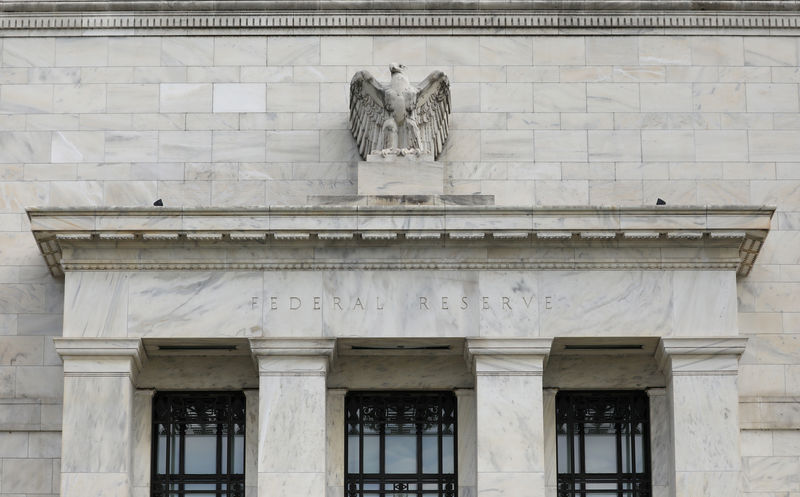By Ann Saphir and Howard Schneider
PALO ALTO, Calif. (Reuters) - Federal Reserve policymakers fear they are ill-equipped to battle the next recession under their current inflation-targeting approach, and this year are well into an effort to vet new strategies for managing interest rates in a world of muted inflation and low borrowing costs.
But for the U.S. central bankers and monetary policy experts who converged in Palo Alto Friday to discuss available options, the challenge was clear: not only will it be difficult to settle on a better framework before the next recession hits, figuring out how to explain it to the public so that it actually works will be a major challenge.
Indeed, just to explain their ideas to each other, Fed policymakers and academics at the Hoover Institution's annual conference displayed slide after slide crammed with equations, lengthy bullet points, and nearly indecipherable charts.
And while most of the PhD economists in the audience presumably understood the theories, "I think where people disagree is, do the assumptions of the model really play out in real life?" Cleveland Fed Bank President Loretta Mester said in an interview on the sidelines of the conference.
In other words, what will really work?
When central bankers around the world reached for unconventional tools like bond buying and forward guidance to fight the 2007-2009 financial crisis, they thought they were facing once-in-a-lifetime conditions.
But a decade on from the end of the Great Recession, it's clear the Fed is dealing with a new economic norm. Neither inflation nor interest rates are expected to rise much even with U.S. unemployment at a near 50-year low.
That leaves the central bank with much less leeway to cut interest rates to stimulate the economy than it historically has had.
So this year, with the U.S. economy on an even keel, interest rate policy on pause, and an expansion set to reach record length this summer, Fed policymakers figure they have a bit of breathing room to figure out how to make policy more effective when the next recession or shock comes along.
Among the ideas: commit to making up for bouts of low inflation with periods of above-target inflation; target economic output, rather than inflation directly; and use negative interest rates to force businesses to invest and banks to lend during downturns.
SHOCK ABSORBERS FOR A NEW WORLD
All would, their advocates say, act as shock absorbers to cushion economic weakness and shorten recessions.
Each would differ, to greater or lesser degrees, from the Fed's current approach, by which it aims for 2 percent inflation and a loosely defined ideal of full employment.
And all would depend critically on households, businesses and financial markets understanding the framework, and reacting accordingly.
Average inflation targeting is the framework option that has attracted the most support so far. The idea, New York Fed President John Williams (NYSE:WMB) explained, is to aim for inflation to average out at 2 percent over a given period - say, a year and a half.
When inflation falls during periods of economic stress, the central bank would respond by keeping easy policy in place until inflation rises above 2 percent and stays there for a time.
If households and businesses know they can count on higher inflation in the future, they will borrow and spend more during recessions, which would theoretically speed the economy's return to health. But for the plan to work, spenders will have to believe the Fed really will drive inflation higher in the future.
By contrast, negative rates would stimulate the economy by punishing businesses for not putting money to work in the economy; if they just keep their money at the bank, they'll end up paying for the privilege. For such a regime to be accepted, however, ordinary people would need to feel sure they wouldn't be punished as well.
Fed policymakers have largely rejected negative rates, but some central banks have tried it and academics like Harvard University professor Kenneth Rogoff, who presented his work at the Hoover conference, maintain it is a viable option.
Not everyone at the conference was sold on the benefits of a new framework, not even the Fed policymakers who were presenting some of the ideas.
"The bar for change is high,” San Francisco Fed chief Mary Daly said. “It can be costly to make mistakes in this space.”
St. Louis Fed chief James Bullard has long advocated a framework known as nominal GDP targeting where the Fed would target a specific level of economic output rather than prices directly.
But even as he gave a new pitch for the idea, he expressed trepidation with such a radical change: experimenting with the way the world's biggest central bank does business, he said, could "unleash chaos" in global financial markets.
One of the challenges of selling a new framework is that for the past 10 years, central banks globally have failed to deliver on their current 2-percent inflation targets, the prevailing international standard.
To Cleveland Fed's Mester, having a set of rules, whatever they may be, could make policy more effective by making it easier for people to understand the aims, and limits, of Fed actions.
And Fed policymakers in Palo Alto seemed keen on exploring new ideas. The Fed has half a dozen more events around the framework review planned for the rest of the year.
Most in the audience gave the Fed credit for tackling the issue. Said Dartmouth College economics professor Andy Levin, "The Fed needs to find something new."
